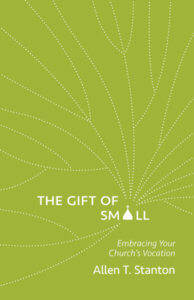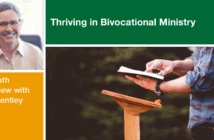Pastors in small-membership churches often face frustration when trying to implement change, but these churches also possess unique adaptability. Allen Stanton notes that small churches can be surprisingly nimble, responding quickly to needs and opportunities. He identifies four practices to help small churches stay flexible. By nurturing these practices, small churches can remain adaptable, leveraging their relational strengths to foster meaningful change while staying true to their mission.
When I work with pastors of small-membership churches, I frequently hear a frustration along the lines of “Our churches don’t want to change.” Adherence to tradition, the way that seemingly small changes are blown out of proportion, or the ways that committees can function can feel maddening. Trying to change them can feel like running into a brick wall over and over again.
But in reality, because small-membership churches are deeply relational places, they can be surprisingly nimble, responding to needs and opportunities with alarming speed. Where large organizations will need to navigate complex staff, detailed policies, and layers of committees, a decision in a small-membership church can be handled with a few strategic phone calls and a meeting in the parking lot.
One of the great gifts of a small church is its nimbleness and adaptability. But like other gifts, the ability to be adaptive and flexible is something that needs to be exercised. These four practices can help small membership churches stay nimble and open to change.
1. Acknowledge ways the church is already adaptive and flexible.
One practice is to acknowledge the places where small-membership churches are already good at change and where they already practice being adaptive and flexible. It might be that volunteers in the worship service are great at filling in when someone has an unexpected absence on Sunday. It might be the way people can quickly pull together a community meal at the last minute. It might be the way people pitch in to help with something at the last minute. These smaller moments of flexibility are often overlooked. By emphasizing them, leaders in small churches can illustrate how flexibility and adaptability are already part of the culture.
2. Remember that not everything needs to change all the time.
Being flexible is great but only if it moves the organization closer to its end goal. An organization’s narratives, traditions, and practices help a community move toward its ultimate goal, which, for the church, is life in the kingdom of God. There are some practices in the church that beautifully form the community in meaningful ways, where changing them might actually be harmful. There are some changes that neither move the community toward its telos nor detract from it. Why spend energy and social capital on those battles? There are some changes that satisfy an individual’s personal preference but actually distract from the telos of the church. I once met a theologian, a lay person, who remarked that every time a new pastor at the church arrived, they made slight changes to the worship service. Each time, they would talk about how this was a more appropriate way to lead the service and that their changes were more theologically sound. The result? The laity disengaged from worship planning and viewed that process as something that was rather unimportant. After all, if every pastor changed it, then it couldn’t be that important, could it? Churches should stay focused on their primary telos and cultivate practices that move them toward it.
By keeping their telos at the center of the church life, the church can better understand how their narratives, traditions, and practices move them closer to their goal. Sometimes, churches will find that the stories they tell about themselves, and the habits of their congregation are helping them move closer to their goal. Why change things that are helping? Other times, a church might discover that by making small, intentional changes in church, they can move closer to their ultimate goal.
3. Capitalize on loose relational networks.
The third custom leaders of small-membership churches should emphasize is the looseness of their relational networks, instead of attempting to adhere to strict hierarchies and complicated bureaucracies. For pastors in more structured denominational systems, this might be more difficult simply because it is assumed that church structures only vary in the size of their hierarchy and bureaucracy. John Kotter reminds us that small organizations, like small-membership churches, are not simple little versions of the same organizational structure. They operate and function in completely different ways.
Embracing the relational networks in a congregation allows decisions to be made in organic ways. Rather than formal meetings, where people may or may not share their opinions, or simply bite their tongue until the meeting in the parking lot, the nature of relational networks allows members of the congregation to freely express their opinions in environments where they are most comfortable. Decisions and plans get hashed out over coffee, in the hallway, and over dinners. This doesn’t mean that the church will entirely dispose of the hierarchies, though. Important work still happens in a meeting. Instead, this embrace of the relational network simply means that church leaders don’t view those committees and the church bureaucracy as its primary path to change. Instead, they recognize that most of the change will happen through more informal processes and finally be affirmed and solidified during the committee meetings.
4. Understand and appropriately manage the roles of individuals within the congregation.
In small-membership churches, a single person can be the difference between leading successful change and derailing the work of the congregation. Pastors need to be aware of the influence of individuals in the congregation as they begin leading change, so that they can spend time with the appropriate people, minimize the dangers to their goals, and build broader support for change within the congregation.
This does not mean, though, that pastors need to honor every person’s emotions or hinge entire decisions and change processes upon one or two people. Instead, they need to be keenly aware of the power dynamics that exist within a congregation. Pastors need to be diligent in spending their time responding to the right people in the midst of change. Those who are obstinately against any transition, while they might offer good feedback from time to time, will likely never be convinced. There’s seldom a good reason to try, unless they hold a large amount of influence or formal power within the congregation. It’s better to let them vent and move along. Meanwhile, those who are energetically supportive of change might offer a morale booster, but they also do not need to be managed. Likewise, those who are ambivalent will follow the rest of the congregation. Instead, effective leaders in small churches spend their time with those who could be swayed. Leaders listen to the fears and take them into account when planning, creating ways to help people feel connected to the broader work of the church. They take individuals’ feedback seriously and incorporate it into the planning process. They spend time one-on-one with the members who are on the fence and help guide them through. They do this because, as a few of these members begin to become supportive, other members follow suit. Eventually, they become supporters who influence others to embrace change as well.
Related Resources
 From The Gift of Small: Embracing Your Church’s Vocation (Fortress Press, 2024) by Allen T. Stanton. Adapted and reproduced by permission of Augsburg Fortress Publishers. The book is available through the publisher, Cokesbury, and Amazon.
From The Gift of Small: Embracing Your Church’s Vocation (Fortress Press, 2024) by Allen T. Stanton. Adapted and reproduced by permission of Augsburg Fortress Publishers. The book is available through the publisher, Cokesbury, and Amazon.
Related Resources
- The Gift of Small featuring Allen Stanton — Watch the Leading Ideas Talks podcast video | Listen to the podcast audio version | Read the in-depth interview
- Small Church Big Impact by Blake Bradford
- Change the Small Church by Roy L. Spore
If you would like to share this article in your newsletter or other publication, please review our reprint guidelines.







